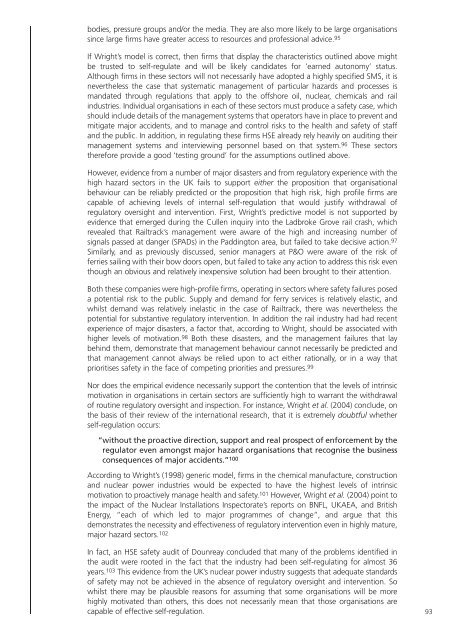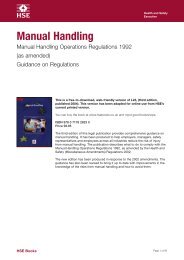Making Companies Safe - what works? (CCA ... - Unite the Union
Making Companies Safe - what works? (CCA ... - Unite the Union
Making Companies Safe - what works? (CCA ... - Unite the Union
Create successful ePaper yourself
Turn your PDF publications into a flip-book with our unique Google optimized e-Paper software.
odies, pressure groups and/or <strong>the</strong> media. They are also more likely to be large organisations<br />
since large firms have greater access to resources and professional advice. 95<br />
If Wright’s model is correct, <strong>the</strong>n firms that display <strong>the</strong> characteristics outlined above might<br />
be trusted to self-regulate and will be likely candidates for ‘earned autonomy’ status.<br />
Although firms in <strong>the</strong>se sectors will not necessarily have adopted a highly specified SMS, it is<br />
never<strong>the</strong>less <strong>the</strong> case that systematic management of particular hazards and processes is<br />
mandated through regulations that apply to <strong>the</strong> offshore oil, nuclear, chemicals and rail<br />
industries. Individual organisations in each of <strong>the</strong>se sectors must produce a safety case, which<br />
should include details of <strong>the</strong> management systems that operators have in place to prevent and<br />
mitigate major accidents, and to manage and control risks to <strong>the</strong> health and safety of staff<br />
and <strong>the</strong> public. In addition, in regulating <strong>the</strong>se firms HSE already rely heavily on auditing <strong>the</strong>ir<br />
management systems and interviewing personnel based on that system. 96 These sectors<br />
<strong>the</strong>refore provide a good ‘testing ground’ for <strong>the</strong> assumptions outlined above.<br />
However, evidence from a number of major disasters and from regulatory experience with <strong>the</strong><br />
high hazard sectors in <strong>the</strong> UK fails to support ei<strong>the</strong>r <strong>the</strong> proposition that organisational<br />
behaviour can be reliably predicted or <strong>the</strong> proposition that high risk, high profile firms are<br />
capable of achieving levels of internal self-regulation that would justify withdrawal of<br />
regulatory oversight and intervention. First, Wright’s predictive model is not supported by<br />
evidence that emerged during <strong>the</strong> Cullen inquiry into <strong>the</strong> Ladbroke Grove rail crash, which<br />
revealed that Railtrack’s management were aware of <strong>the</strong> high and increasing number of<br />
signals passed at danger (SPADs) in <strong>the</strong> Paddington area, but failed to take decisive action. 97<br />
Similarly, and as previously discussed, senior managers at P&O were aware of <strong>the</strong> risk of<br />
ferries sailing with <strong>the</strong>ir bow doors open, but failed to take any action to address this risk even<br />
though an obvious and relatively inexpensive solution had been brought to <strong>the</strong>ir attention.<br />
Both <strong>the</strong>se companies were high-profile firms, operating in sectors where safety failures posed<br />
a potential risk to <strong>the</strong> public. Supply and demand for ferry services is relatively elastic, and<br />
whilst demand was relatively inelastic in <strong>the</strong> case of Railtrack, <strong>the</strong>re was never<strong>the</strong>less <strong>the</strong><br />
potential for substantive regulatory intervention. In addition <strong>the</strong> rail industry had had recent<br />
experience of major disasters, a factor that, according to Wright, should be associated with<br />
higher levels of motivation. 98 Both <strong>the</strong>se disasters, and <strong>the</strong> management failures that lay<br />
behind <strong>the</strong>m, demonstrate that management behaviour cannot necessarily be predicted and<br />
that management cannot always be relied upon to act ei<strong>the</strong>r rationally, or in a way that<br />
prioritises safety in <strong>the</strong> face of competing priorities and pressures. 99<br />
Nor does <strong>the</strong> empirical evidence necessarily support <strong>the</strong> contention that <strong>the</strong> levels of intrinsic<br />
motivation in organisations in certain sectors are sufficiently high to warrant <strong>the</strong> withdrawal<br />
of routine regulatory oversight and inspection. For instance, Wright et al. (2004) conclude, on<br />
<strong>the</strong> basis of <strong>the</strong>ir review of <strong>the</strong> international research, that it is extremely doubtful whe<strong>the</strong>r<br />
self-regulation occurs:<br />
“without <strong>the</strong> proactive direction, support and real prospect of enforcement by <strong>the</strong><br />
regulator even amongst major hazard organisations that recognise <strong>the</strong> business<br />
consequences of major accidents.” 100<br />
According to Wright’s (1998) generic model, firms in <strong>the</strong> chemical manufacture, construction<br />
and nuclear power industries would be expected to have <strong>the</strong> highest levels of intrinsic<br />
motivation to proactively manage health and safety. 101 However, Wright et al. (2004) point to<br />
<strong>the</strong> impact of <strong>the</strong> Nuclear Installations Inspectorate’s reports on BNFL, UKAEA, and British<br />
Energy, “each of which led to major programmes of change”, and argue that this<br />
demonstrates <strong>the</strong> necessity and effectiveness of regulatory intervention even in highly mature,<br />
major hazard sectors. 102<br />
In fact, an HSE safety audit of Dounreay concluded that many of <strong>the</strong> problems identified in<br />
<strong>the</strong> audit were rooted in <strong>the</strong> fact that <strong>the</strong> industry had been self-regulating for almost 36<br />
years. 103 This evidence from <strong>the</strong> UK’s nuclear power industry suggests that adequate standards<br />
of safety may not be achieved in <strong>the</strong> absence of regulatory oversight and intervention. So<br />
whilst <strong>the</strong>re may be plausible reasons for assuming that some organisations will be more<br />
highly motivated than o<strong>the</strong>rs, this does not necessarily mean that those organisations are<br />
capable of effective self-regulation. 93
















